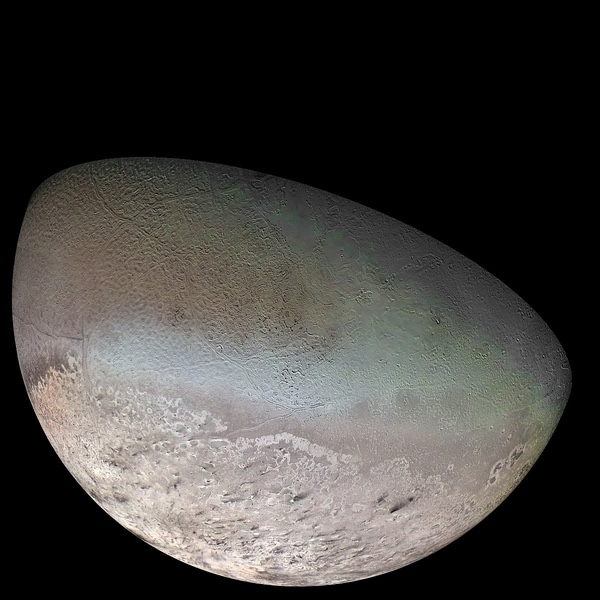All the myriad worldsby Dwayne Day
|
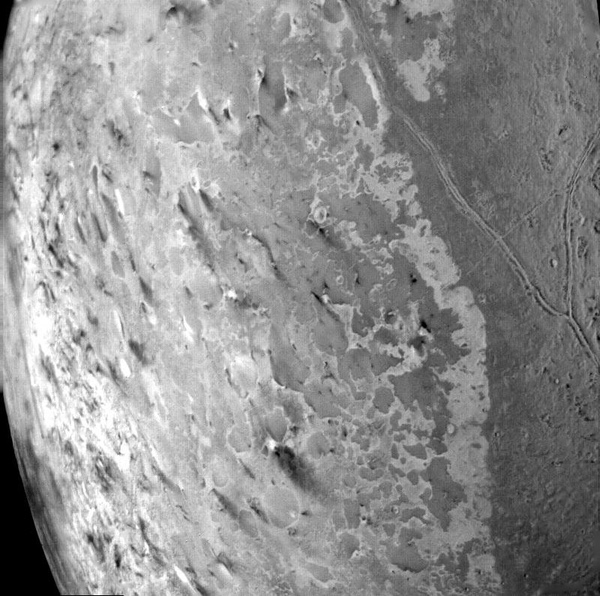 The black smudges on Triton are signs of cryovolcanism. They are pointed in a certain direction, indicating that winds are blowing them after the material is ejected from the surface. (credit: NASA) |
Triton
Back in 1989, Voyager 2 flew past Neptune, the last target on its trip out of the solar system and into the great beyond. As it approached Neptune, I don’t think people expected much. Voyager 2’s earlier encounter with Uranus had not excited a lot of people, perhaps because Uranus was just a hazy bluish-green orb.
| Triton could be the key to a new definition of where life can exist in the universe. |
But Neptune proved to be different. As Voyager got closer the planet appeared to be bluer, and prettier than Uranus. In the media, reporters waxed poetic about the alluring azure of this ice giant on the edges of our solar system, clearly captivated by it.
Then Voyager detected “the great white spot,” a swirling cloud feature moving across Neptune’s surface that reminded people of Jupiter’s Great Red Spot. Voyager revealed Neptune to be a dynamic planet, not a dull orb. This was an early hint that our expectations about the outer solar system needed reexamination. Yes, it is cold and dark way out there at the corner of No and Where, but that doesn’t mean nothing is happening. It does not mean that the planets and their moons are simply frigid, dead, featureless objects. More could be going on.
At the time, I was going to my local planetarium for a regular show about the Voyager encounter (see “One last, first time,” The Space Review, July 13, 2015.) This was in the pre-Internet age, so the ability of the public to obtain updates on a space mission only a few hours after the images reached the ground was still novel. The show featured the latest information from JPL about what they were seeing, and it was fascinating. I cannot remember if the Triton revelations came about at that time or a bit later, but they were eye-opening for me.
Triton is one of Neptune’s moons, the largest, and it is an oddball. It circles the planet backwards, retrograde, in the opposite direction of Neptune’s other moons. This indicates that it did not form with them, and was likely captured when it wandered in from the Kuiper Belt. Triton was discovered shortly after the discovery of Neptune in 1846. Triton is cold, with estimated temperatures of 38 K (−235 °C). That, and its origins, combine to make it very interesting, and intriguing.
 Triton orbits in the opposite direction of Neptune’s other moons, indicating that it is a captured Kuiper Belt Object. (credit: ESO/L. Calçada) |
When Voyager 2 imaged Triton, it revealed a relatively young surface, geographically speaking. Instead of ancient craters, it was smooth and covered with ice. Scientists did not expect that. Soon they spotted a greater surprise: dark smudges on the surface that seemed to flow in a certain direction. Planetary scientist Larry Soderblum speculated that these were the result of some kind of geothermal activity on Triton, perhaps geysers. And soon more images indicated that there were active geysers on Triton, with material spewing up from the surface and then taking a ninety-degree angle as it hit upper atmosphere winds. Geysers! And winds! On what should have been a cold dead rock!
This was when I fell in love with Triton. Both Neptune and Triton had surprised us. Much later I had the luck to work with Larry Soderblum and told him that I was impressed that he had discovered the geysers on Triton. He corrected me: he had not discovered the geysers, Voyager 2 discovered them, Larry had only explained what they were. And that was perhaps the Voyager missions’ greatest gift: the lesson that no matter where we go in the solar system, when we look at something new, we are likely to be surprised.
There are two prevailing theories about where those geysers come from. The first—and more mundane—is that sunlight is penetrating through the icy surface and heating up material below that bursts out through the ice as a geyser. The second theory has far greater implications. The theory is that Triton has a water ocean below its ice, like Europa, Enceladus, and possibly some other moons, and that internal heating is causing that water to burst out as geysers. That would mean liquid water, energy, and maybe minerals—the necessary ingredients required for life.
A few years ago, some scientists proposed a space mission named Trident that would fly past Triton. Their mission did not get selected by NASA, but it offered an intriguing idea: that if an ocean does exist under Triton’s ice, it could dramatically expand our definition of where life can form in the universe. Our current search for exoplanets is based on the theory that we want to detect planets in the “habitable zone” around other stars, defined as the zone where liquid water could exist on a planet’s surface. But now scientists are intrigued with the possibility that there could be life in oceans under the icy surfaces of Jupiter’s moon Europa and Saturn’s moon Enceladus. If there could be water, and possibly life, under an icy surface of a captured Kuiper Belt object, that means that life could exist far from a star. It may not be detectable ever, but it could change our concepts of what “habitable” means for planets. Life could be anywhere and everywhere.
Triton could be the key to a new definition of where life can exist in the universe.
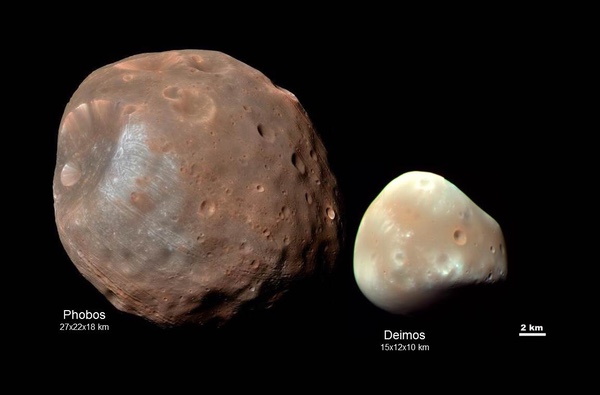 The two martian moons Phobos and Deimos are either captured asteroids or formed along with Mars or soon afterwards. A Japanese mission that will retrieve samples from Phobos should be able to definitively answer their origin story. (credit: NASA) |
Phobos
Phobos, like its sister Martian moon Deimos, is a mystery moon for many reasons. It also has a great backstory. Both moons share many characteristics with certain types of asteroids. This has led to the theory that they are captured main belt asteroids. One problem with this theory—a big problem, actually—is that they have very circular orbits that lie almost exactly in Mars’ equatorial plane. If they were captured, there’s no good reason to believe they would end up exactly at the equator, and therefore this requires a complicated explanation to unravel the mystery of how they ended up where they are. Another theory is that Phobos and Deimos coalesced in orbit after Mars formed, possibly as the result of a giant collision with Mars. That theory also has problems.
| A good sample returned from Phobos would answer the question of where it (and Deimos) comes from, whether it is a captured asteroid or a piece of the same stuff as Mars. |
Planetary scientists have many theories about the origins of many different objects in our solar system. But one of the aggravating things about science is that definitive answers are difficult to come by. Even after bringing hundreds of kilograms of samples back from Earth’s moon there is still disagreement on how it formed. But Phobos is different. A good sample returned from Phobos would answer the question of where it (and Deimos) comes from, whether it is a captured asteroid or a piece of the same stuff as Mars. We already have meteorites from asteroids and even meteorites from Mars. It would not be difficult to compare a sample from Phobos to those other samples and answer that question, solving that mystery once and for all. Fortunately, the Japanese plan on doing exactly that. Their MMX mission, for Martian Moons eXploration, is planned to launch in 2024, land on Phobos in 2025, and bring back samples by 2028. So we should have an answer soon afterwards. The answer will inevitably lead to more questions—that’s how science works—but the big question of whether Phobos and Deimos are captured asteroids or formed with Mars should finally be solved within a few years.
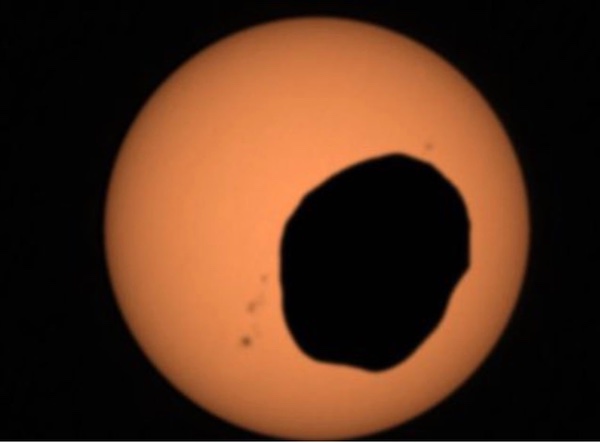 Phobos eclipsing the sun in a recent image taken from the surface of Mars. (credit: NASA) |
Phobos has proven to be a difficult target—several previous missions to the moon ended in failure. In July 1988, the Soviet Union launched Phobos 1 and 2 towards Mars. Phobos 1 was lost a few months later when it was accidentally shut off. Phobos 2 made it to Mars by January 1989. It returned some blurry images of Phobos, and then it stopped transmitting. In 2011, the Russian Space Agency launched Fobos-Grunt, a Phobos sample return mission. But the spacecraft, which had suffered numerous problems in development, immediately failed in Earth orbit. It’s almost as if Phobos is taunting us. MMX will now be the fourth dedicated mission to Phobos, and hopefully will be successful.
There have been many American proposals for robotic missions to Phobos over the years, with names like PANDORA, Aladdin, and HALL, but none were selected, so Japan’s decision to fly a mission has probably made a lot of American Phobos aficionados happy, even if they wish they were doing the mission themselves. (I am planning on writing an article about Phobos mission proposals and am interested in hearing about past concepts.)
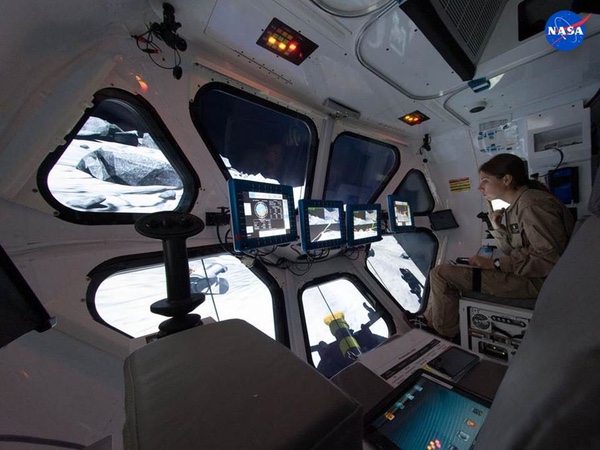 In 2015–16 NASA studied how a human exploration of Phobos could take place. One option was a dedicated excursion vehicle that would essentially rendezvous with the moon. (credit: NASA) |
In 2015, a NASA team at Johnson Space Center also studied how astronauts might explore Phobos if they were already in Mars orbit. The moon’s very low gravity makes human exploration tricky. The team determined that a spacecraft that could touch down on Phobos and enable astronauts to collect samples using robotic arms would be useful. Astronauts could also perform EVAs while still tethered to the spacecraft and using maneuvering units.
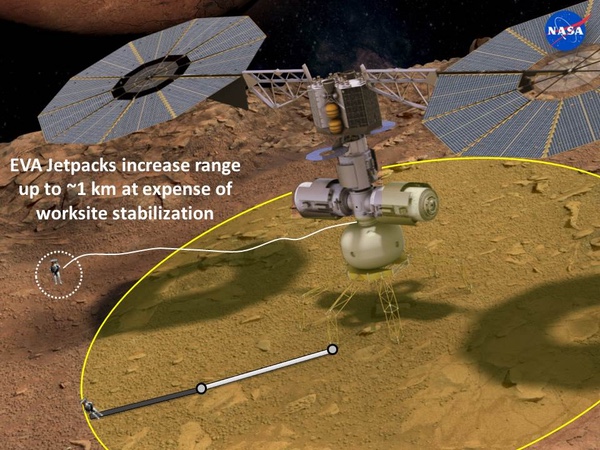 The 2015–16 NASA study of the human exploration of Phobos sought to address how astronauts could collect samples while still staying safe in Phobos’ very low gravity. Options included tethers, robotic arms like those used on the space shuttle, and maneuvering units. (credit: NASA) |
Phobos has featured a number of times in fiction. The 1966 book Colossus, by Dennis Feltham Jones, spawned the 1970 movie Colossus: The Forbin Project, about a supercomputer that takes over the world. The book had two sequels. In The Fall of Colossus, humans manage to shut down the Colossus computer, but when they do, they learn that the two moons of Mars are suddenly heading towards Earth, and are apparently alive. In the third book, Colossus and the Crab, humans discover that Phobos and Deimos are sentient machines, like Colossus, and they enslave humanity.
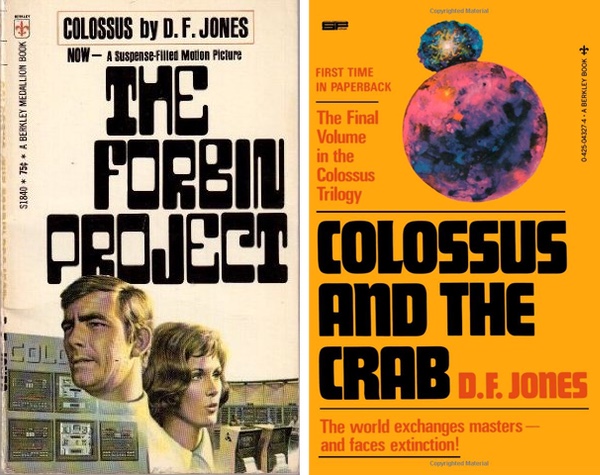 |
Phobos was also the site of the popular 1990s video game Doom, as well as a forgettable movie by the same name and several sequel games. And in the television series “The Expanse”, Phobos is the site of a Mars defense facility that Earth’s military blows up as a demonstration of force. How many other moons, besides Earth’s moon, feature so prominently in fiction?
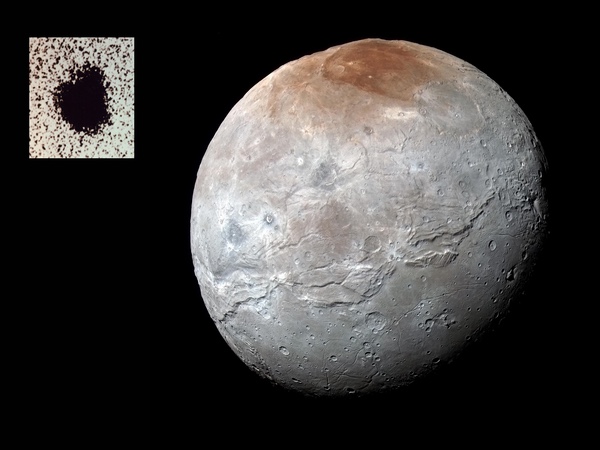 Pluto’s moon Charon has an unusual surface. One hemisphere is much smoother than the other and has been resurfaced, possibly due to cryovolcanism. The moon was discovered in 1978—it is that little blob off the edge of Pluto in the telescope photo at upper left—and finally studied in detail in 2015. (credit: NASA) |
Charon
Charon is the largest moon of Pluto, and in fact is the largest moon relative to its parent body in our solar system—from Pluto’s surface it would loom ominously in the sky. The accurate pronunciation is “Karon” with a hard “K” sound. But the man who discovered the moon suggested that it have the softer “Sharon” pronunciation, and NASA has followed this direction.
| Once the New Horizons images of Charon came back, it became clear that there was something unusual about this moon. |
Charon makes the list for some of the same reasons as Triton. It was discovered in 1978 and I can still remember being excited to learn that Pluto had a large moon. Like Pluto, until the New Horizons flyby in 2015, it was only a blurry blob in the best telescope images. I remember being in a room with a bunch of planetary scientists back in 2010 when one of them showed us the latest Hubble images of the Pluto system—Charon was a few fuzzy pixels. When New Horizons zoomed past it five years later, it became a world, with ridges, mountains, complex features, and a weird surface color.
Like Triton, and Pluto, Charon has a young surface. We should have expected a big cratered rock, lifeless and uninteresting—artwork of Pluto and Charon from before the New Horizons encounter showed worlds with many craters. That’s not what we discovered. Charon is large relative to Pluto, and Pluto’s gravity has certainly stretched it and morphed it in ways that are still not well understood. As yet there is no sign of current geologic activity on either Pluto or Charon, but New Horizons data is still being analyzed.
Once the New Horizons images of Charon came back, it became clear that there was something unusual about this moon. The northern hemisphere is rough and the southern hemisphere is smooth. That southern region has been named Vulcan Planitia, and one puzzling aspect of it is that the smooth part curves where it meets at the equatorial ridge that delineates the two hemispheres. According to Madison Borrelli, a graduate student at Arizona State University who has written about it, the bending could be caused by something heavy sitting on it, although another explanation could be cryovolcanism. Vulcan Planitia also has two mountains named Clarke and Kubrick Mons which are surrounded by deep moats. One theory is that these mountains could be the remnants of large crystal blocks which once sat on the surface and then sank when the region heated up and was resurfaced.
Although it will be many years before another mission ventures to Pluto and Charon, computer modeling of how the two bodies interact will keep improving, enabling a better understanding of what may be happening there. As Borrelli notes, Voyager 2 only imaged one half of the large moons of Uranus, and a future mission might show that their other halves are entirely different.
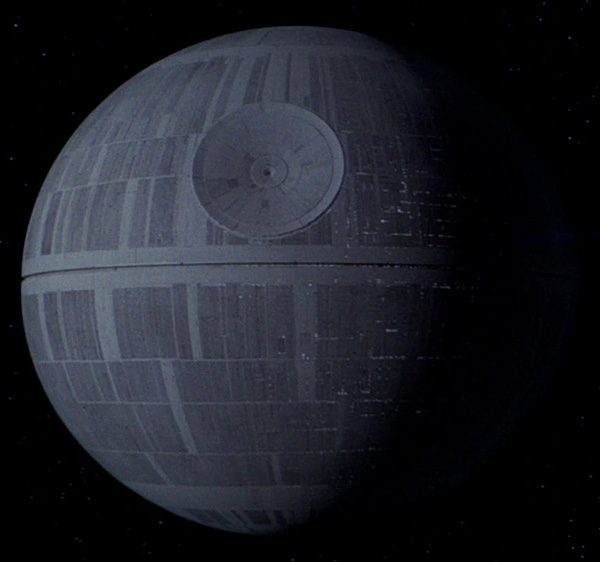 Wait, that’s no moon… (credit: Disney) |
The Death Star
Site of some of the best Penne all’Arrabbiata in the galaxy.
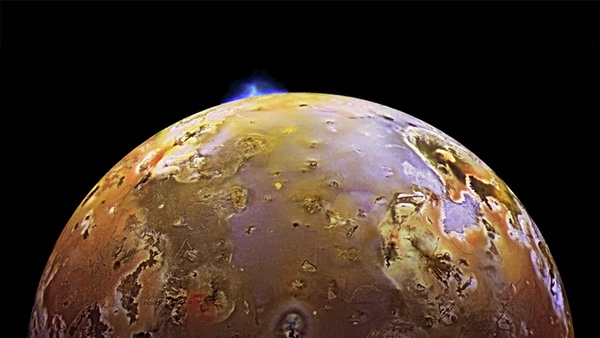 Jupiter’s moon Io is incredibly volcanically active. There have been several proposals over the last two decades to send a mission there to study it and how it interacts with Jupiter. (credit: NASA) |
Io
By now, some readers are hopping mad: What about Europa? What about Enceladus? What about Titan? These moons are okay, I guess… They already have their fan clubs (Europa used to have its own congressman). Titan confuses me. It’s mostly about chemistry, a subject I never studied. And objects that appear to be amorphous, featureless blobs from space are, well, hard to get excited about. The Huygens probe provided some tantalizing glimpses of Titan’s surface. When the Dragonfly helicopter gets there, maybe I’ll get more enthusiastic about it.
In the next decade, a European spacecraft will provide significant data on Jupiter’s moon Ganymede, the largest moon in the solar system. Ganymede is so big that it has its own magnetosphere. The more we learn about it in the 2030s, the more interesting it will become.
| We may see an Io mission selected for development in the next decade. Or maybe the Chinese will choose to do it instead. |
But I would probably go with Jupiter’s volcanic moon Io, the most geologically active body in the solar system. It is so tortured by Jupiter’s gravity that it has heated up and is constantly erupting with more than 400 active volcanos that are resurfacing it with sulfur. It is hell. There are many moons in the solar system that are unique, but Io stands out by itself—no other moon is that active.
There have been several proposals for missions to Io over the past decade and a half. None has been selected for development. Fortunately, the barrier to entry (i.e. the cost) for an Io mission has gotten lower during that time. In the 2000s, an Io mission would have required expensive radioisotope thermoelectric generators. But the Juno mission demonstrated that solar panels at Jupiter’s distance from the sun are viable. Research performed in the design of the Europa Clipper mission can also be applied to an Io mission design. An Io spacecraft could now study the moon by conducting multiple flybys. We may see an Io mission selected for development in the next decade. Or maybe the Chinese will choose to do it instead.
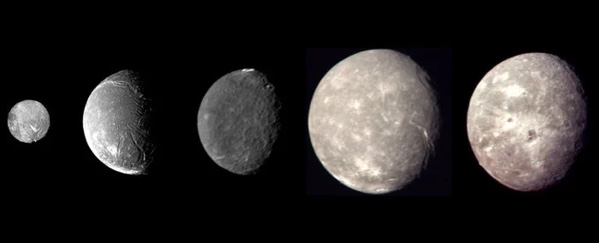 The moons of Uranus appear rather classic. But Voyager 2 revealed only one side of them, and based upon what we have since learned about Triton, Pluto, and Charon, these moons could be much more diverse than we expect. (credit: NASA) |
Runners up
If one of the above moons suffers an accident (perhaps it blows up because of an exposed thermal vent) there are others that could move up on my list.
The Uranian moons are not very exciting, but the few Voyager pictures we have of them are pretty—they are stark, black and white objects that look like what we would expect to find out at the edge of the solar system. Their family portrait looks like something Ansel Adams would have photographed. They do have some of the best names in the solar system, named after magical spirits in English literature like Miranda, Ariel, Umbriel, Titania, and Oberon. Just as Uranus orbits the sun on its side, the Uranian moons also orbit their planet in a plane perpendicular to Uranus’ orbit around the sun. How Uranus and its moons ended up like this is a big mystery.
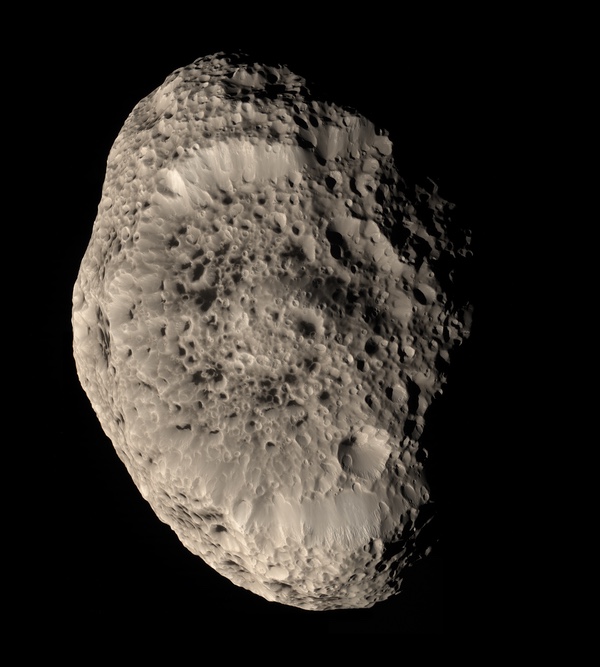 Another Saturnian moon that has defies conventional understanding. It has a density about the same as water, and probably has many interior voids. (credit: NASA) |
There are a couple of Saturn’s moons that intrigue me: Mimas and Hyperion. Cassini’s extended romp around the Saturnian system provided opportunities to explore many of the ringed giant’s moons. And many of them are weird. They have often been shaped by interactions with Saturn’s rings, and some of them, known as “Shepherd moons,” shape the rings themselves. It’s fascinating to consider that Saturn’s rings and its moons are really just a range of differently-sized objects swirling around the planet—the rings consist of dust and ice particles and objects the size of icebergs. Some of the moons have been battered around by large rocks and icebergs that once also orbited Saturn. And others appear to have built up structures from more gentle processes where ring material has settled on their surfaces, like snow drifts on a cratered rock. Mimas and Hyperion are not Shepherd moons, but they have been shaped by their interactions with ring debris swirling around Saturn.
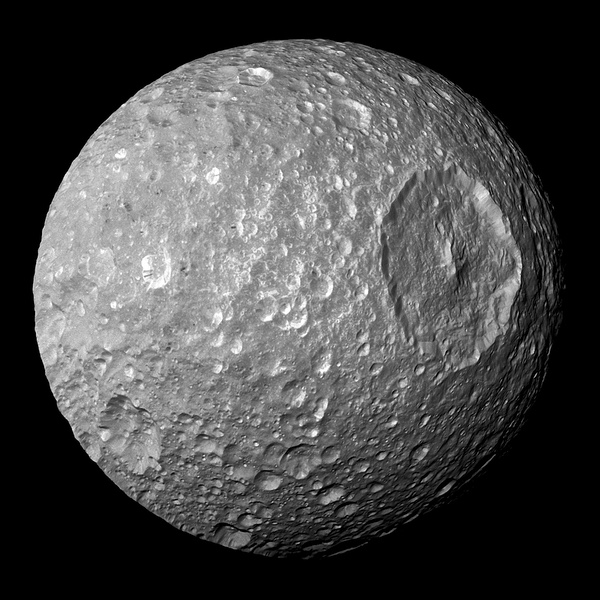 Mimas, a moon of Saturn that looks a bit familiar. (credit: NASA) |
Mimas is cool for the same reason that the fourth moon on this list is cool. Hyperion is cool because, well, it has a great name—sorta like a comic book superhero—and it looks like a sponge, like it has been totally smashed up over eons of interactions with debris around Saturn. Hyperion’s density is only slightly higher than that of water, and its pockmarked surface may be due to high concentrations of methane or carbon dioxide. When it was hit by objects, they formed deep indentations that have not filled in. The surfaces of both Mimas and Hyperion tell stories, but we will probably only know tiny bits of how they came to look the way they look, unless, maybe, somebody mounts a mission to Hyperion (which has a pretty catchy name, doesn’t it?)
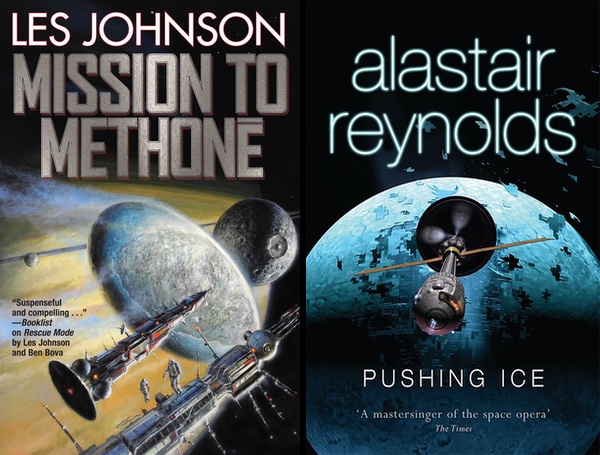 Several books have been written about moons of the solar system that turn out to be alien spaceships. These are examples of what Peter Nicholls has referred to as “big dumb objects”, which he said were efforts to introduce wonder into hard science fiction stories. |
Big dumb objects
Most of the rest of my runners up are Saturnian moons. Several of Saturn’s moons have featured in recent novels. Alastair Reynolds’ 2005 book Pushing Ice had the moon Janus suddenly accelerating out of the solar system when it turned out it was an alien spaceship. Les Johnson’s 2018 novel Mission to Methone had the moon Methone suddenly… turn out to be an alien spaceship.
| I don’t need an alien spaceship to find a big dumb object that inspires wonder. |
You might think that with Phobos, Deimos, Janus, and Methone all featuring as alien spaceships in novels there is a bit of a theme going on, something that science fiction critic Peter Nicholls, speaking in 1997, labeled “big dumb object” science fiction stories. Nicholls proposed that stories where human characters encounter giant objects in space that defy understanding—Arthur C. Clarke’s Rendezvous With Rama is the classic example—are “about being dwarfed by space and hugeness…” They are stories about wonder.
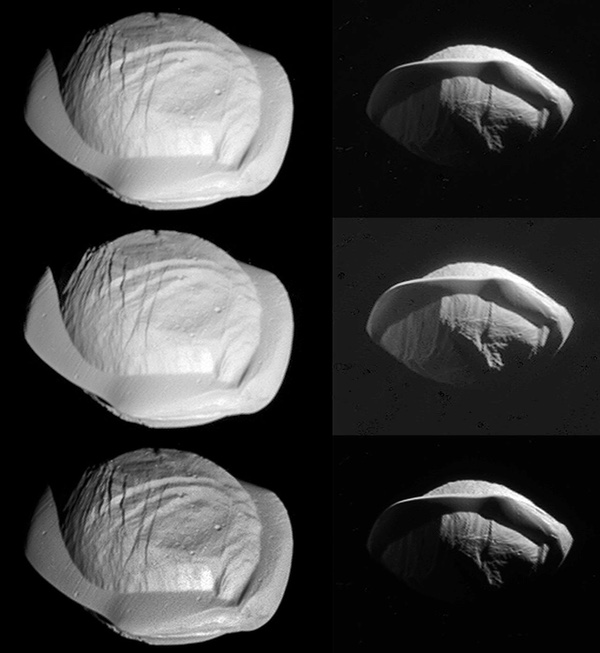 Pan, One of Saturn’s very odd moons. (credit: NASA) |
For me, I don’t need an alien spaceship to find a big dumb object that inspires wonder. For example, there’s Iapetus, which has an equatorial ridge running around its edge that must be wild to see from the surface. Whatever explorer sets foot there hundreds of years from now will be awestruck. Similarly, there are Saturn’s Shepherd moons Atlas, Daphnis, and Pan. Like Iapetus, they also have equatorial ridges that may have been formed from material accreted from Saturn's rings. Look at the pictures that Cassini took of them as it passed by and now try to comprehend how they ended up looking so weird. You have to start thinking in geologic time, over millions of years. It’s mind-bending and mind-expanding.
Isn’t that what we want from a planetary object, something that pushes us to wonder? What more can we ask from a moon?
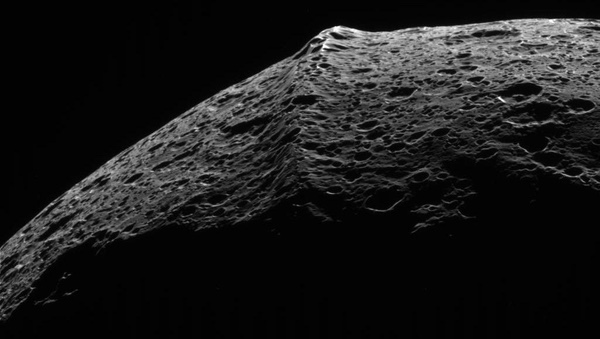 Saturn’s moon Iapetus has a high equatorial ridge. Imagine standing on the surface and seeing that ridge loom ahead of you. (credit: NASA) |
Note: we are using a new commenting system, which may require you to create a new account.
